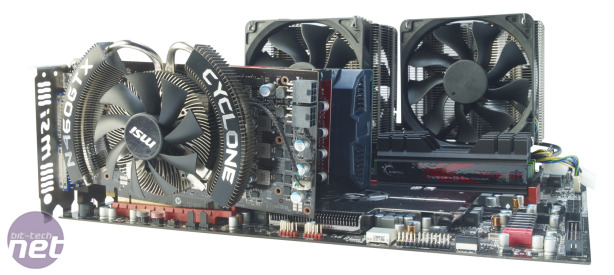Performance Analysis
The most important thing to consider when analysing the performance of the SR-2 is what you use your PC for and therefore what applications you run.For instance, in our Media Benchmarks, which test the ability of a PC to complete three everyday consumer-orientated tasks, namely editing photos, encoding video and multi-tasking several applications at once, the SR-2 was barely any faster than a fast single-socket motherboard.
For example, out of the box, the SR-2 with Xeon X5680s scored 1,465, 3,220 and 1,440 in the individual tests, for an overall score of 2,042. In contrast, the single-socket Asus P6TD Deluxe with Core i7-980X EE CPU scored 1,428, 3079 and 1,498 for an overall score of 2,002. Given that the Xeon system would set you back around three times more than the Core i7 system, the SR-2 clearly isn’t a sensible purchase if you mostly run these sorts of applications.
A dual-processor Xeon system also isn’t a great purchase if all you’re interested in is gaming frame rates. Few games as it is run any faster on a 6-core CPU than a quad-core CPU, and none at all see any benefit from the 24 execution units of a dual Xeon system. That said, our Crysis benchmarks do prove that unlike a lot of dual-processor motherboards the SR-2 is no slower than single-socket motherboards in games, so it’s definitely worth considering as the basis for a dual-purpose work/gaming system.
Next on our list of tests was wPrime, a synthetic maths calculating benchmark. What’s interesting about wPrime is that it scales very well across multiple cores, with the pair of Xeon X5680s proving an astonishing 78 per cent faster than the Core i7-980X EE. The wPrime benchmark also highlighted that while the SR-2 is great for overclocking, it isn’t the fastest dual-Xeon motherboard around, as the Supermicro X8DTU-F, beat it in wPrime and several other tests. This is hardly surprising given that Supermicro has been making dual-processor motherboards for decades, while the SR-2 is EVGA’s first such board.
The Supermicro X8DTU-F also proved faster than the SR-2 in both Cinebench tests. However, while the former is a very straightlaced motherboard that doesn’t support overclocking, the SR-2 can speed up your Xeons. For example, in Cinebench 11, the SR-2 increased the score of its Xeon X5650s from 13.56 to 19.22 when overclocked, a performance increase of 42 per cent. What’s more, the overclocked X5650s were significantly faster than the X5680s, which scored 17.03 at their stock speed.
The four other professional application benchmarks we ran on the SR-2 all tell a similar story. Our CPU rendering test in LightWave 9.6 for example ran 44 per cent faster on the overclocked X5650s in the SR-2 than on the stock speed X5650s in the Supermicro X8DTU-F. FlamMap didn’t show as much of a difference, but there was still an additional 20 per cent extra performance to be had from overclocking. The CFD calculating benchmark Euler3D showed results midway between LightWave and FlamMap, with a 32 per cent performance boost from overclocking. The landscape generator Terragen 2 showed the least benefit from overclocking, with only a 12 per cent reduction in rendering time.
As the SR-2 was tested with a single ATI Radeon HD 5870 graphics card and the Supermicro X8DTU-F with basic on-board graphics it’s not fair to compare their power consumption. However, it’s interesting to see that at both idle and load a dual Xeon system doesn’t consume anywhere near twice as much power as a single-socket system, despite having two sets of memory and double the number of many circuits. For example, at load, with a pair of stock speed X5650s, the SR-2 only drew 68W more than the Core i7-980X system. That said, once we had overclocked the X5650s, the SR-2 system turned into a real energy guzzler, drawing 211W more watts at the wall.
We also tested the SR-2 with four 768MB Nvidia GeForce GTX 460 graphics cards fitted to see how many Folding@home points per day you can squeeze out of a single PC. The result, not to say the temperature of our lab, was extraordinary. With the CPUs running the bigadv client and the four GPUs each running an instance of the GPU3 client, the SR-2 is an epic folder. With the cheaper X5650s at their stock speed the rig as a whole was capable of folding through 90,112ppd, a simply amazing achievement. With the CPUs overclocked the score rose even further, to 123,516ppd. Of course, this means that the pair of overclocked X5680s in the SR-2 were even faster, together with the four GPUs, outputting a ludicrous 132,329ppd. These results are simply incredible, and even faster than the £25,000+ 64-core Nehalem EX rig we tested earlier this year.

MSI MPG Velox 100R Chassis Review
October 14 2021 | 15:04











Want to comment? Please log in.